Picto Diary - 22 June 2017 - Finish
I expected to take I-84 and I-15 to Harrison Motorsports, Sandy, UT, where I would drop off the bike for service, tires, and general refitting after a 6000 mile ride. TIMDT said she'd pick me up. We'd go somewhere for dinner - probably 'Cheese - and then home to Park City. Distance Boise, ID to Salt Lake City, UT: 350 miles.
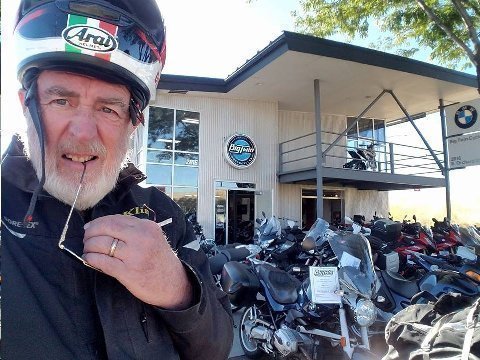
Above: Bishop at Big Twin Motorcycles, Boise, ID. 22 June 2017.
There was a McDonald's on Orchard Road as I rode the BMW F800 GS motorcycle north from the Bond Hotel to I-84 and the route home. Today's ride would be just a short 350 miles to the BMW motorcycle dealer in Salt Lake City UT, where I planned on dropping the bike off for service and new rubber.
I stopped for a sausage biscuit with egg and a coffee. By the time I had finished breakfast and gotten back on the road, it was about 9:00 AM when I came to Big Twin Motorcycles, at the intersection of Orchard Road and I-84 - opening time.
I don't know anyone at Big Twin today, but, Big Twin figured strongly in my early motorcycling days and I have always held an affinity for them, usually taking the time to stop by when I'm in Boise.
Big Twin had just opened, so, I stopped.
Last year while at Big Twin I asked a parts guy if they had a BMW tank bag for my 2012 F800 GS motorcycle. I've learned to do without tank bags... I stuff my pockets with pressure gauges, ear plug holders, maps, multitools etc. as a substitute for a tank bag. Big Twin didn't have a tank bag in stock. So, I rode on without one.
Today, Big Twin had the right tank bag in stock. But, it would have taken thirty minutes or more to get in installed... you have to take of the seat off... yada yada... and I was in a hurry. So, impatient as I was to get going, I didn't buy the bag.
How does Big Twin figure into my motorcycling life?
In 1997 TIMDT and Mwah (sic) bought a second home in Park City. We call it the "Yellow House." We own and rent out the "Yellow House," in Park City's Old Town, to this day.
In 1998 we decided to start spending more time in Park City at the Yellow House. I was working a job in Phoenix, AZ. I had just purchased a BMW R1100 GS motorcycle at Iron Horse Motorcycles in Tucson, and I decided that I would ride it to Park City and keep it there.
The ride from Phoenix to Park City is about 750 miles. When I arrived in Park City, after a great, scenic ride, the new bike was due for its 600 mile check up at a BMW motorcycle dealer.
I called BMW of Salt Lake, then located on 35th South near Redwood Road, and asked for a service appointment. I didn't know anyone there, so I just asked for the service department.
The guy at the other end of the phone said, "Look buddy. We're flat out. We can't get your bike in here for another three months."
"Whaaaa?!!" I exclaimed. "I can't ride the bike and stay within the warranty if I don't get it serviced!"
"Sorry," he said. "We can't help."
"How do I get the bike serviced?" I asked.
"Well" the BMW of SL guy said, "why don't you take it up to Boise's Big Twin Motorcycles?"
The idea seemed far fetched... but, the prospect of a motorcycle ride to Boise also stimulated my wanderlust. I had never been to Boise. Why not check it out?
I called Big Twin. "Sure," their service representative said, "we can do the service any time. Bring the bike in. We'll give you a loaner motorcycle to ride around Boise while we do the service."
Talk about a difference in approach from one dealership to the other!
Well... that's what I did. I rode the bike up to Boise, via I-84, to get it serviced. As a fairly new motorcycle touring aficionado, I rode through my first heavy rainstorm between Snowville, UT and Burley, ID. I had hoped to get to Boise in one day... I had only 350 miles to cover... but, I was soaked, not having prepared for rain, so I stopped in Burley, 150 miles from Boise, to dry out. I spent the night in Burley at a Best Western motel.
The next day everything worked well. I left Burley early, was in Boise by 9:00 AM, and delivered the R1100 GS to Big Twin. I took Big Twin's loaner bike, a Triumph Bonneville, for a spin around Boise, and then picked up my serviced "GS" later in the afternoon. I rode forty miles to Mountain Home, ID, stayed the night, and rode home the next day.
The notion of taking a vehicle 350 miles (700 mile round trip) to get it serviced seems pretty far fetched. But, it happened and I had a pretty good time in the process.
Still, looking to the future, I couldn't let the fact that I would have to wait three months to get a bike serviced at my local dealer unaddressed.
Some Park City riding friends said I should talk to the owner of BMW of Salt Lake to complain about getting stiffed on the service appointment. They made an introduction.
I told the owner my story and he was aghast, honestly so, it appears in hindsight. He said he talk to the employee who gave me the bum's rush and make things right in the future. He lived up to his promise and things were "right" with BMW of Salt Lake thereafter... until this day, 20 years later, after three additional dealership ownership changes.
The then owner of BMW of Salt Lake is now a salesman at Salt Lake's Dave Strong Porche. He's sold me two Cayenne's since he's been there.
But, one can see, I think, why I have a special affinity for Big Twin in Boise, ID. I've bought tires and clothing there, stopping by many times over the years since that iconic service appointment in '98.
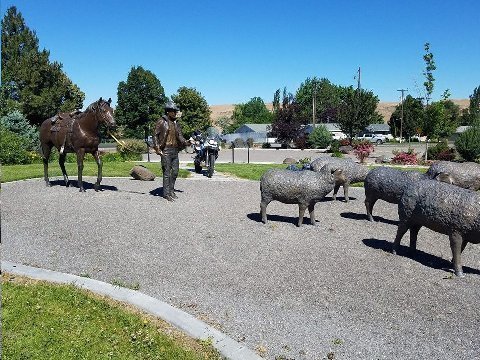
Above: Hagerman Sheep Monument, Hagerman, ID. US 30. 22 June 2017.
I-84 follows the Snake River across the state of Idaho. The Snake River for much of its Idaho flow, established the route of the Oregon Trail.
Before, I-84, US 30 was the way to travel east or west, following the Snake River, across southern Idaho.
Despite the presence of I-84, US 30 has been kept active. The route parallels I 84 and tracks through small towns and the fertile farmland of the Snake River plain.
US 30 is a slower route. Speed limits are lower...max 65 mph compared to I-84's 80 mph. And, towns along the way periodically slow the rider to in-town speed limits.
But, I was feeling curious. I had ridden US 30 a couple of times west of Twin Falls, but never east of Twin Falls. Now was a chance to have a new riding experience. I'd delay my arrival home by one or two hours, depending on what I stopped to see, but, I might not have another opportunity to check out this area.
I stopped at the Hagerman Sheep Monument.
Here's an excerpt about the Hagerman Sheep Monument from the Hageman Chamber of Commerce:
In the late 1800’s, sheepherders in the Idaho Territory worked in the Hagerman Valley. The majority of sheepherders were Basque. A herder and his Australian Shepherd or Border Collie sheepdog could handle a band of 1,500 to 2,000 sheep.
The Hagerman Valley was an attractive wintering location for sheep ranching because of plentiful year-round spring water that didn’t freeze due to milder winters and protection from harsh early spring storms during lambing. In addition there were many acres of irrigated land that produced alfalfa and grain for winter feed.
An inscription on the monument reports “In 1882 the Oregon Short Line arrived in Shoshone and Bliss. This provided a means of getting wool and sheep to market which led to enormous growth in sheep numbers. Bliss became a major shipping center for the Jarbidge and Three Creek areas, and had a large shearing plant. A branch line was quickly extended to Ketchum and Hill City by 1884. By 1914 over 300,000 sheep were being trailed through Ketchum. Hill City and Ketchum were two of the largest sheep shipping centers in the U.S.”
The monument was dedicated in 2013. For Dennis the Menace's benefit, my bike can be seen parked amidst the bronze cast sheep!
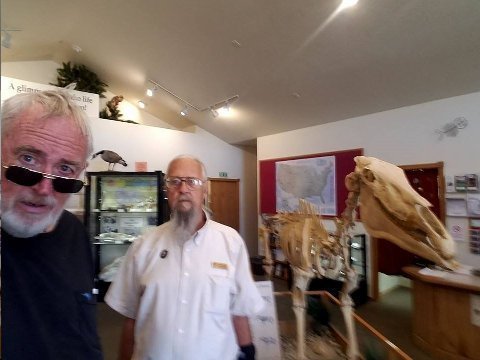
Above: Bishop, docent Richard, and 3.5 million year old Hagerman Horse (plaster cast). Hagerman Fossil Beds National Monument visitors' center. 22 June 2017.
Hagerman Fossil Beds National Monument is the preeminent location in North America for fossil species from the time period called the Pliocene Epoch... 2.6 to 5.3 million years ago... relatively recent on the geologic time scale. The dinosaurs disappeared from the earth during the Paleocene era, 65 million years ago, to put the Pliocene in context.
The fossil beds were exposed by major flooding through the Snake River Valley 15,000 years ago, when land gave way at nearby Lake Bonneville. The residual lake of Lake Bonneville is the Great Salt Lake.
The best known species discovered at Hagerman is the Hagerman Horse, a zebra like ancestor of today's horse, and one of the first early horse like specimens to have a one toed hoof. 20 complete skeletons of the Hagerman Horse were retrieved. One fossilized skeleton is on permanent exhibit at the Smithsonian Museum in Washington, D.C. Hagerman is the only fossil sight in the world where specimens of the Hagerman horse have been found, along with seven other species exclusively located here.
Climate change? During the Pliocene this area was a grassy plain with ponds and forest stands which then received over twice today's 7 to 10 inches of annual precipitation.
Evidence of other animals at Hagerman include saber-toothed cats, mastodons, camels, ground sloths, hyena like dogs, beavers, muskrats, otters, antelope, deer, fish, frogs, snakes and waterfowl.
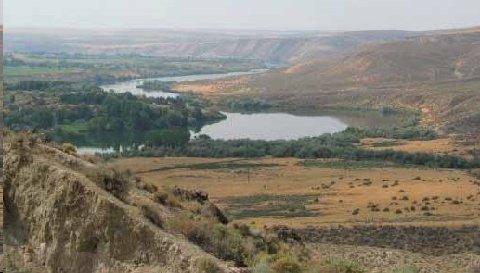
Above: Hagerman Fossil Beds National Monument. File image. 22 June 2017.
The image looks east. To the right of the Snake River are the flood eroded bluffs where the Pliocene era fossils are exposed.
There is a permanent team of National Park Service employed geologists which continue to explore the fossil beds.
Travel and learn!
This little visited National Park's site was fascinating. My serendipitous decision to take the US 30 back road has paid off by providing some very interesting stops, so far, along the way.
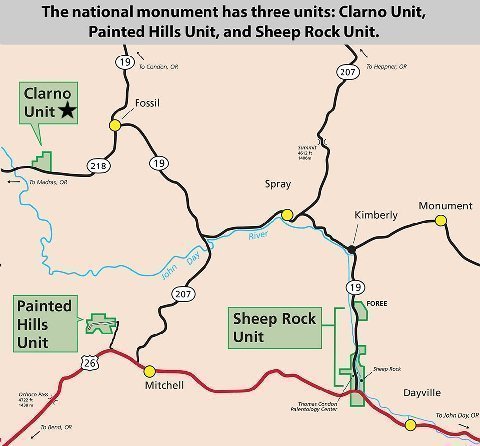
Above: Map. John Day Fossil Beds National Monument, Clarno Unit, near Fossil, OR.
Earlier on this trip, on 03 June 2017, I stopped at John Day Fossil Beds National Monument, Clarno Unit, in Oregon. That day, I had started my ride in Ashland, OR with a destination of Walla Walla, WA where I would stay with great hosts, John Galt and Dagny Taggart.
Clarno Unit fossils were found in exposed mudflows that formed 54 to 40 million years ago in the Oligocene period, a lush semi-tropical rainforest environment. Species founded here include a four-toed horse, huge rhino-like brontotheres, crocodilians, and meat-eating crodonts.
I suffer from "exploding head syndrome" when I try to think about geologic time.
"Man," in close approximation to what the species is today, has been around for about ten thousand years... hardly a micro second when the earth's age of 4.6 million years is reduced to a hypothetical, twenty four hour clock.
Even the Pliocene, when the Hagerman Horse ran free, circa 3.5 million years ago is only a "minute" or so ago when measured on the 24 hour geologic clock.
The two fossil bed national monuments that I visited on the current "Alaska/Yukon Ride," both in the US, one at the outset and the other near the end of the trip, show periods separated by fifty million years!
One thing noted in visiting these geologic sites is the radical changes of climate and topography that have occurred over the millennia. We can't perceive it readily now within the miniscule time frames of our own existence, but, on the geologic clock, the earth continues in its evolutionary, creative, and adaptive process. One day, the Yellowstone caldera will blow. One day the Pacific tectonic plate will shift radically. One day another huge meteor will strike the earth, as occurred in the Yucatan, 70 million years ago. We live in a dynamic, evolving universe. Nothing stays the same.
It is inevitable that the earth, at some point, will become inhospitable for human habitation. Mankind's destiny, I believe, is to hedge its bets for survival by locating humans someplace other than planet earth. Hat tip: Elon Musk, Jeff Bezos, and Stephen Hawking.
The Hagerman Horse is no longer around today. The species failed to adapt to changing climate and the physical conditions of its environment. So, it is with any species... a species must adapt to survive. So it is with species mankind... adapt and survive.
As a corollary, trying to stop the evolutionary, creative, and climate changes of the earth is a fool's errand. Mankind is far away from understanding the forces that guide the earth's evolution, let alone those that govern the universe.
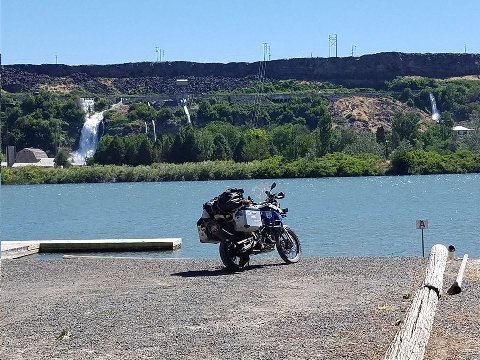
Above: Thousand Springs. US 30 west of Twin Falls, ID. 22 June 2017.
Water springs directly out of the rock into the Snake River.
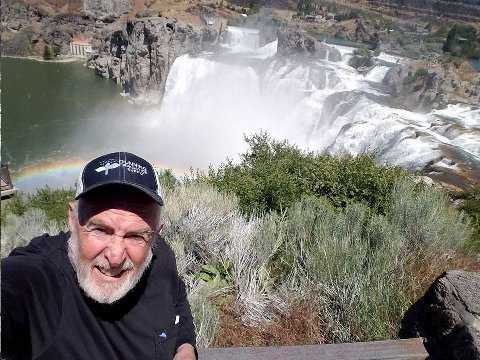
Above: Bishop at Shoshone Falls. Twin Falls, ID. US 30. 22 June 2017.
I was here late summer ten years ago when the falls were running at a trickle. I had to see Shoshone Falls at full bore, so I stopped. I wasn't disappointed!
At 212 feet, Shoshone is 45 higher than Niagra Falls. The falls was formed by the same catastrophic flooding outburst from Lake Bonneville, during the Pleistocene ice age, 14,000 years ago, that exposed the fossil beds where the Hagerman Horse was discovered.
20K cubic feet of water per second flows over the falls during Spring of a high run-off water year, such as this year. In a dry year, late summer, the runoff can be as low as 300 cubic feet per second. Much of the Snake's water is diverted before the falls for use in irrigation.
Seeing the burgeoning Snake, I was reminded, once again, of the high water I have seen everywhere throughout my ride.
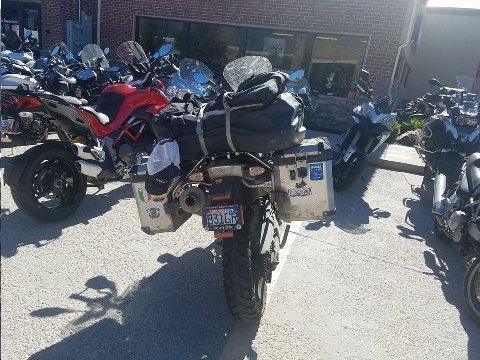
Above: BMW F800 GS at Harrison Motor Sports. Sandy, UT. 22 June 2017.
Finish.
Park City, UT to Dawson City, YT and Tok, AK and return.
6163 motorcycle riding miles.
350 Inside Passage ferry miles.
Addendum:
I will read "The Floor of Heaven ". You've got me interested. But I can answer your question about the American spirit. We do have a new paradigm. We are headed the way of Europe. Less initiative. Less self reliance. More a sense of entitlement.
Dennis the Menace,
Atlanta, GA
Agree... sadly. Hunker down. It was good living at the apex.
So Boise, Idaho was not your. Favorite stop, but the trip is fascinating.
Bridge,
Palm Beach, FL